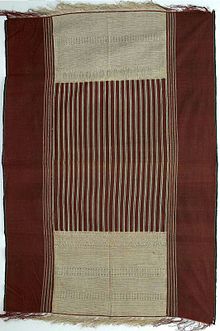Ulos
Ulos ( Kain ulos ) are traditional, rectangular, hand-woven cloths of the Toba Batak in the north of the island of Sumatra , Indonesia . With the Karo-Batak the cloths are called uis . At Batak weddings, Ulos is used to designate all "female" goods (gifts) from the bride's parents to the young couple, which is seen as a symbol of protective power.
Manufacturing and sales
The production of the cloths has been preserved in some regions to this day. They were and are made on backbelt looms. Today, fully mechanical looms have mainly taken over the function, with semi-automatic step looms also being used. The wipes produced are mainly sold in the Pematang Siantar and Kabanjahe markets , where there is high demand from intermediaries and direct buyers. Ulos have very different styles and ceremonial meanings. Often these are orders from the various Batak regions, such as the Simalungun or Angkola Bataks.
Ulos in ceremonial life
Particularly valuable and symbolic Ulos are used at weddings and funerals, as well as on the occasion of bone reburial, a traditional ancestor worship based on the central belief. The scarves are not only worn, but also exchanged according to set rules. More respected people consider subordinate people.
In the wedding rite, the donation expresses the fact that congratulations and blessings accompany the bride and groom. The confirmation and consolidation of the newly formed family relationship is no less in the foreground. The Ulos ragidup (pattern of life cloth) that is exchanged is given by the father of the bride to the mother of the groom and represents the most symbolic cloth of the Toba Batak, often made using the Ikat technique. The Batak specialty of this technique is that another chain for the white-ground end panels is hooked into the chain of the middle section of the cloth (consisting of several parts) and interwoven with it (connection of two chains in one weaving process).
A special moment at a wedding, besides giving the cloth as a present, is putting it on. The actual marriage takes place by wrapping the bride and groom in a ragi hotang . The performing father of the bride expresses his blessings. The Ulos sitoluntuho is used in poor families .
Small children are given so-called Ulos mangiring by their maternal grandparents . These towels are much narrower.
The Ulos ragidup is also used at funerals and bone transfers . Corpses, coffins and exhumed bones are covered with this symbolic cloth.
Research deficits
In addition to the aforementioned cloths, the Toba Batak knew other traditional textiles that were important in the ritual and ceremonial context. Many of them are no longer produced, or the name or motif of the decorations are known only to a few, if at all. Only the dimensions of the cloths or their origin allow conclusions to be drawn. In this way, hip or shoulder cloths ( Ulos ragi na marpusoran or bintang maratur ) can be identified. Another traditional hip scarf was the Ulos ni tondi . It was about the soul ( tondi ), which is why this cloth had to be selected very carefully. It had a special power and accompanied a person for a lifetime.
Mourning and headscarves ( tumtuman ) can no longer be proven beyond doubt.
literature
- Achim Sibeth: Batak. Live with the ancestors. People of Indonesia . Stuttgart, London 1990.
- David Gintings: The Society and Culture of the Batak Karo . Medan 1993.
Individual evidence
- ^ Indonesian Traditional Textiles: Holding That Thread of Thought
- ↑ Waldemar Stöhr, The Old Indonesian Religions, Part 3, Volume 2 , p. 23
- ↑ Achim Sibeth, Living with the ancestors BATAK - People in Indonesia, Chapter 6 - Arts and Crafts , p. 126 ff. (Here: p. 192, 200)
- ↑ MS Gittinger, Selected Batak Textiles: Technique and Function in: Textile Museum Journal 4 Hf. 2: 14
- ↑ Achim Sibeth, Living with the ancestors BATAK - People in Indonesia, Chapter 6 - Arts and Crafts , p. 126 ff. (Here: p. 192, 204)
- ^ Robyn J. Maxwell, Textiles of Southeast Asia: tradition, trade and transformation , p. 119


